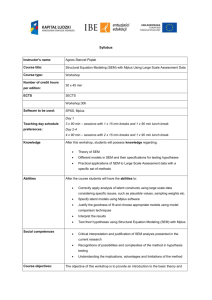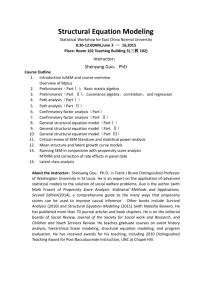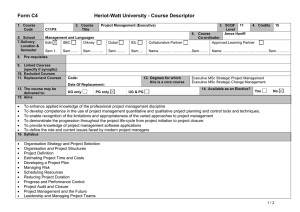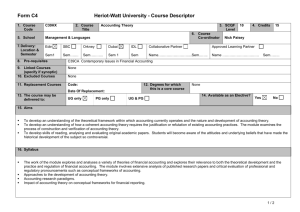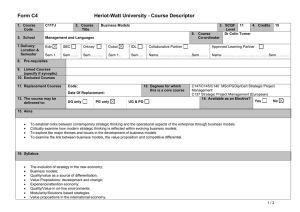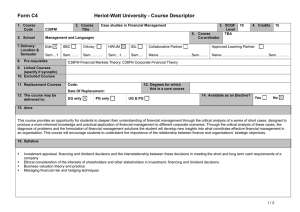The University of North Carolina at Chapel Hill Spring Semester, 2016
advertisement
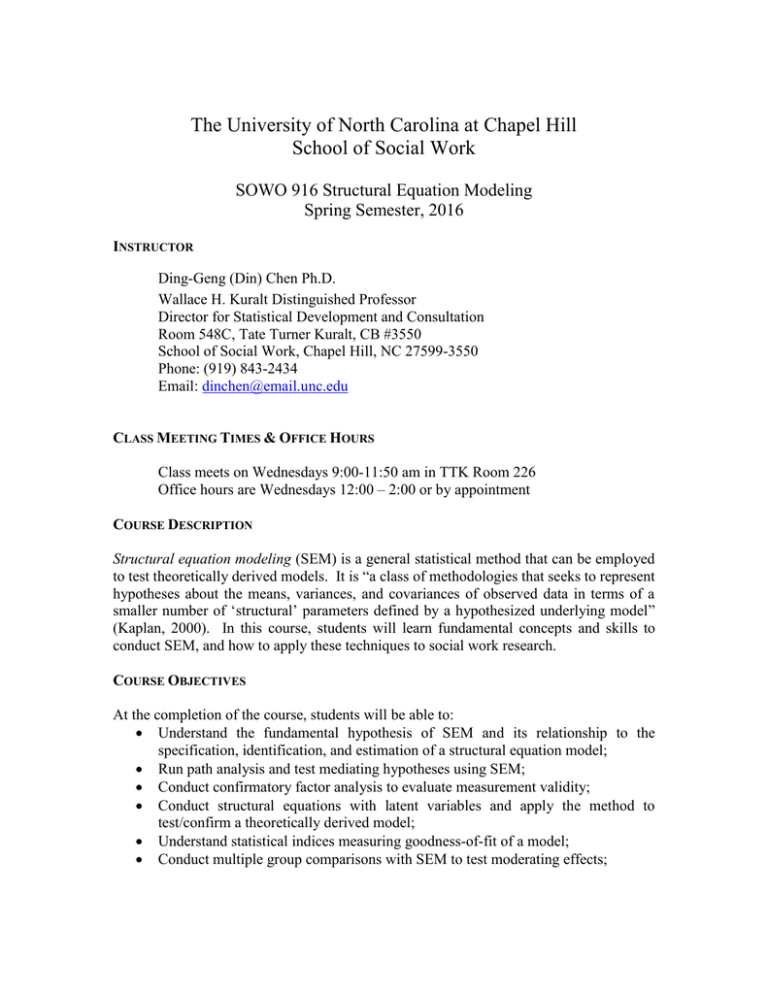
The University of North Carolina at Chapel Hill School of Social Work SOWO 916 Structural Equation Modeling Spring Semester, 2016 INSTRUCTOR Ding-Geng (Din) Chen Ph.D. Wallace H. Kuralt Distinguished Professor Director for Statistical Development and Consultation Room 548C, Tate Turner Kuralt, CB #3550 School of Social Work, Chapel Hill, NC 27599-3550 Phone: (919) 843-2434 Email: dinchen@email.unc.edu CLASS MEETING TIMES & OFFICE HOURS Class meets on Wednesdays 9:00-11:50 am in TTK Room 226 Office hours are Wednesdays 12:00 – 2:00 or by appointment COURSE DESCRIPTION Structural equation modeling (SEM) is a general statistical method that can be employed to test theoretically derived models. It is “a class of methodologies that seeks to represent hypotheses about the means, variances, and covariances of observed data in terms of a smaller number of ‘structural’ parameters defined by a hypothesized underlying model” (Kaplan, 2000). In this course, students will learn fundamental concepts and skills to conduct SEM, and how to apply these techniques to social work research. COURSE OBJECTIVES At the completion of the course, students will be able to: Understand the fundamental hypothesis of SEM and its relationship to the specification, identification, and estimation of a structural equation model; Run path analysis and test mediating hypotheses using SEM; Conduct confirmatory factor analysis to evaluate measurement validity; Conduct structural equations with latent variables and apply the method to test/confirm a theoretically derived model; Understand statistical indices measuring goodness-of-fit of a model; Conduct multiple group comparisons with SEM to test moderating effects; Perform power analysis with SEM and know how to determine minimum sample size needed; Understand basic concepts and skills to deal with interactions and quadratics in latent variables, and categorical variables; Understand the linkage between SEM and hierarchical linear models, and conduct multilevel analysis and latent growth curve analysis with SEM; Understand strategies for dealing with missing data. PRE-REQUIREMENT Students are assumed to be familiar with descriptive and inferential statistics. A solid understanding of multiple regression analysis is a key. They should have statistical and statistical software background at least equivalent to that provided by SOWO919 (applied regression analysis and generalized linear models), SOCI209, PSYC282, EDUC284 (linear regression), or SOCI211 (categorical data analysis). SOFTWARE PACKAGES Students may choose to use SAS, SPSS, or Stata for data management and matrix calculations. Class examples in these areas will be in Mplus. The course will employ Mplus for running SEM. Mplus is available through the university’s Virtual Computer Lab. Students are expected to use the Lab’s help resources to learn how to establish connections with the Lab. TEXTBOOKS Required: Byrne, B. M. (2012). Structural equation modeling with Mplus. New York: Routledge. (In short in this class: BBM.SEM) Recommended for students who will be conducting SEM’s in their futures: Bollen, K. A. (1989). Structural equations with latent variables. New York, NY: John Wiley & Sons. Bowen, N. K., & Guo, S. (2011). Structural Equation Modeling. New York, NY: Oxford University Press. Hoyle, R. H. (Ed.). (2012). Handbook of structural equation modeling. New York: Guilford Press. Kline, R. (2011). Principles and Practice of Structural Equation Modeling, 3rd Ed., New York: NY: Guilford Press. ASSIGNMENTS Team Application Activities 4 Homeworks Midterm Exam Final Exam TOTAL GRADE PERCENTAGE 15% 40% 20% 25% 100% 2 GRADING SYSTEM The standard School of Social Work interpretation of grades and numerical scores will be used. H = 94-100 P = 80-93 L = 70-79 F = 69 and below POLICY ON CLASS ATTENDANCE Class attendance is critical for team performance and individual learning. You are expected to attend all scheduled sessions. Each class session will cover a great deal of material, and you will fall behind in the course when you miss even one class. In addition, your team will be disadvantaged by your absences. It is your responsibility to inform the instructor in advance about missing a class session. Starting after the second absence, your course grade will be reduced by 10% for each session missed. This reduction will occur after the calculation of your final grade and will be in addition to the effects absences may have on your peer evaluations. If you miss a class, you are responsible for obtaining all notes, announcements, handouts, and assignments from the missed class from your classmates. If you miss three classes, you will be expected to meet with the instructor and Associate Dean of Student Services to discuss if further participation in the course is possible. A grade of incomplete will only be given under extenuating circumstances and in accordance with University policy. POLICY ON INCOMPLETE AND LATE ASSIGNMENTS Assignments are to be turned in to the instructor at the beginning of class on the due date noted in the course outline if the class meets on a due date. If assignments are sent by email, do not assume they have been received until confirmation is received. Extensions may be granted by the professor given advance notice of at least 24 hours and extenuating circumstances. Unannounced late assignments will automatically be reduced 10%. An additional 10% grade reduction on the assignment will occur for each day late (including weekend days). A grade of incomplete will only be given under extenuating circumstances and in accordance with University policy. POLICY ON ACADEMIC DISHONESTY In-class activities are designed to create a collaborative learning environment. However, graded assignments are to be completed totally independently. Once an assignment has been handed out, it is assumed that students will not discuss any aspect of the assignment together—not even general principles or topics related to the assignment. Such exploring or sharing of knowledge that is even peripherally related to class assignments gives an unfair advantage to students who have peers from the same department or school enrolled in the course. Violations constitute violations of the honor code and will be treated as such. 3 Please include the honor code statement along with your signature on all assignments: “I have neither given nor received unauthorized aid on this assignment.” This statement indicates to the instructor that you did not consult with students or other human sources on any aspect of the assignment. It also represents your pledge that you have not made use of information or materials related to graded assignments from last year’s course. For assignments that are open book and take home (such as homeworks), consulting non-human sources (text and online sources) is encouraged. For example, you may read existing SEMNET postings, articles and Powerpoints about topics that are posted online, and book chapters, but you may not post a question related to an assignment to a discussion board. All questions about assignments and these policies should be referred to the instructor. Please refer to the APA Style Guide (6th edition), the SSW Manual, and the SSW Writing Guide for information on attribution of quotes, plagiarism and appropriate use of assistance in preparing assignments. If reason exists to believe that academic dishonesty has occurred, a referral will be made to the Office of the Student Attorney General for investigation and further action as required. POLICY ON ACCOMMODATIONS FOR STUDENTS WITH DISABILITIES Students with disabilities that affect their participation in the course and who wish to have special accommodations should contact the University’s Disabilities Services and provide documentation of their disability. Disabilities Services will notify the instructor that the student has a documented disability and may require accommodations. Students should discuss the specific accommodations they require (e.g. changes in instructional format, examination format) directly with the instructor immediately after the first class session and before the second class session. Retroactive accommodations will not be implemented. The instructor is happy to make any necessary accommodations to ensure optimal learning for every student. POLICIES ON THE USE OF ELECTRONIC DEVICES IN THE CLASSROOM We will discuss the use of laptops for in-class activities on the first day. The use of electronic devices for non-class related activities (e.g. checking messages, playing games) is prohibited. If any such uses occur during class time, laptops will not be allowed for any students for the remainder of the course. 4 OUTLINE OF COURSE TOPICS AND READINGS Session 1(1/13): Introduction to SEM and Team-based Learning(TBL) 1. Intro to TBL 2. Intro to SEM Required Reading: Chapter 1: BBM.SEM Become versatile at gaining access to Mplus 7 at the UNC virtual lab, and finding files on your computer while using the virtual lab. Mplus can be accessed at virtuallab.unc.edu. Intra- and inter-team information sharing is encouraged. The virtual lab website also has helpful information. Session 2(1/20): Using Mplus for SEM 1. Specification—Path diagrams, equations, Mplus syntax 2. Direct and indirect effects Required readings for today: Chapter 2: BBM.SEM Recommended reading: Bagozzi, R. P., & Yi, Y. (1988). On the evaluation of structural equation models. Journal of the Academy of Marketing Science, 16(1), 74-94. Session 3(1/27): First-Order Confirmatory Factor Analysis Model: Testing the Factorial Validity of a Theoretical Construct 1. The Hypothesized Model 2. Mplus Input File Specification and Output File Results 3. Hypothesis 2: Self-Concept Is a Two-Factor Structure 4. Mplus Input File Specification and Output File Results 5. Hypothesis 3: Self-Concept Is a One-Factor Structure Required readings: Chapter 3: BBM.SEM Kline, R. (2005). Principles and practice of structural equation modeling, 2nd ed. New York, NY: Guilford Press. pp. 105-120, 131-150. Session 4 (2/3): First-Order Confirmatory Factor Analysis Model: Testing the Factorial Validity of Scores From a Measuring Instrument 1. The Measuring Instrument Under Study 2. The Hypothesized Model 3. Mplus Input File Specification and Output File Results Required readings 5 Chapter 4: BBM.SEM Homework 1 Assigned and is due by 5pm, 2/9. Session 5(2/10): Second-Order Confirmatory Factor Analysis Model: Testing the Factorial Validity of Scores From a Measuring Instrument 1. The Hypothesized Model 2. Analysis of Categorical Data 3. Mplus Input File Specification and Output File Results Required readings: Chapter 5: BBM.SEM Recommended readings: Bollen, K. A. (2000). Modeling strategies: In search of the Holy Grail. Structural Equation Modeling 7, 74-81. Byrne, B. M. (2005). Factor analytic models: Viewing the structure of an assessment instrument from three perspectives. Journal of Personality Assessment, 85(1), 17-32. Session 6(2/17) Testing the Validity of a Causal Structure: Full Structural Equation Model 1. The Hypothesized Model 2. Mplus Input File Specification and Output File Results 3. Post Hoc Analyses Homework 2 Assigned and is due by 5pm, 2/24. Required readings: Chapter 6: BBM.SEM Recommended readings: Bentler P. M. & Mooijaart, A. (1989). Choice of structural model via parsimony: A rationale based on precision. Psychological Bulletin, 106, 315-317. Werner, C. & Schermelleh-Engel. (2010). Deciding between competing models:Chi-square difference tests. (Posted at website.) Retrieved in 2013 at: http://user.uni-frankfurt.de/~cswerner/sem/chisquare_diff_en.pdf Session 7 (2/24): Testing the Factorial Equivalence of a Measuring Instrument: Analysis of Covariance Structures 1. Testing Multigroup Invariance: The General Notion 2. Testing Multigroup Invariance Across Independent Samples 3. The Hypothesized Model 6 4. Mplus Input File Specification and Output File Results Required readings: Chapter 7: BBM.SEM Recommended readings: Eid, M., Nussbeck, F. W., Geiser, C., Gollwitzer, M., Cole, D. A., & Lischetzke, T. (2008). Structural equation modeling of multitrait-multimethod data: Different models for different types of methods. Psychological Methods, 13, 230-253. Pohl, S., & Steyer, R. (2012). Modeling traits and method effects as latent variables. In S. Salzborn, Davidov, E., & Reinecke, J. (eds.). Methods, theories, and empirical applications in the social sciences. Wiesbaden, Germany: Springer. Session 8(3/2): Testing the Equivalence of Latent Factor Means: Analysis of Mean and Covariance Structures 1. Testing Latent Mean Structures: The Basic Notion 2. The Hypothesized Model 3. Testing Multigroup Invariance 4. Mplus Input File Specification and Output File Results 5. Testing Multigroup Invariance: Other Considerations Homework 3 Assigned and is due by 5pm, 3/8. Required readings: Chapter 8: BBM.SEM Recommended readings: Iacobucci, D. (2010). Structural equations modeling: Fit indices, sample size, and advanced topics. Journal of Consumer Psychology, 20(1), 90-98. Anderson, J. C. and D. W. Gerbing (1988). Structural equation modeling in practice A review and recommended two-step approach. Psychological Bulletin 103, 411-423. Rothbard, N. P. (2001). Enriching or depleting? The dynamics of engagement in work and family roles. Administrative Science Quarterly, 46, 655-684. Session 9 (3/9): Testing the Equivalence of a Causal Structure: Full Structural Equation Model 1. Cross-Validation in Structural Equation Modeling 2. Testing Invariance Across Calibration and Validation Samples 3. The Hypothesized Model 4. Mplus Input File Specification and Output File Results Midterm Assigned and is due by 5pm, 3/22. 7 Required Readings: Chapter 9: BBM.SEM Recommended readings: Enders, C. K., & Bandalos, D. L. (2001). The relative performance of full information maximum likelihood estimation for missing data in structural equation models. Structural Equation Modeling, 8, 430-457. 3/16: HAVE A GOOD SPRING BREAK! Session 10(3/23): Testing Evidence of Construct Validity: The MultitraitMultimethod Model 1. The General CFA Approach to MTMM Analyses 2. The Hypothesized Model 3. Mplus Input File Specification and Output File Results 4. Examining Evidence of Construct Validity at the Matrix Level 5. Examining Evidence of Construct Validity at the Parameter Level 6. The Correlated Uniquenesses Approach to MTMM Analyses Required readings: Chapter 10: BBM.SEM Recommended readings: Boomsma, A. (2000). Reporting analyses of covariance structures. Structural Equation Modeling: A Multidisciplinary Journal, 7(3), 461-483. Session 11 (3/30): Testing Change Over Time: The Latent Growth Curve Model 1. Measuring Change in Individual Growth Over Time: The General Notion 2. The Hypothesized Dual-Domain LGC Model 3. Mplus Input File Specification and Output File Results 4. Hypothesized Covariate Model: Age and Surgery as Predictors of Change Required readings: Chapter 11: BBM.SEM Recommended readings: Cole, D. A. & Maxwell, S. E. (2003). Testing meditational models with longitudinal data: Questions and tips in the use of structural equation modeling. Journal of Abnormal Psychology, 112, 558-577. Session 12 (4/6): Testing Within- and Between-Level Variability: The Multilevel Model 1. Overview of Multilevel Modeling 2. The Hypothesized Model 8 3. Mplus Input File Specification and Output File Results Required readings: Chapter 12:BBM.SEM Recommended readings: Curran, P. J., & Willoughby, M. T. (2003). Implications of latent trajectory models for the study of developmental psychopathology. Development and Psychopathology, 15. 581-612. HW4 Assigned and is due by 5pm, 4/12. Session 13 (4/13): Structural Equation Modelling using Stata, SAS and R 1. SEM With Stata with examples 2. SEM with SAS with example 3. SEM with R with Examples Lecture note will be provided Session 14 (4/20): Review of SEM with advanced Topics Lecture note will be provided Session 15 (4/27): Final Exam 9
